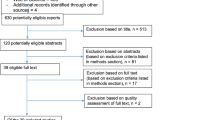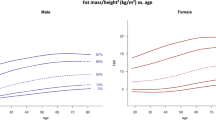Abstract
Objective:
The aims of this cross-sectional study were (1) to examine the effect of age on body composition in older adults using dual-energy X-ray absorptiometry (DXA) and (2) to evaluate the agreement of DXA with standard indirect anthropometric measures (body mass index (BMI), waist circumference and waist-to-hip ratio (WHR)).
Research methods and procedures:
A population-based sample of 731 adults aged between 50 and 79 years underwent measurement of BMI, waist circumference, WHR, DXA total body fat mass, DXA % total body fat, DXA % trunk fat and DXA lean body mass. Linear regression was used to test for trend in measures of body composition between age categories in men and women. Partial correlations and Bland–Altman analysis were used to examine the agreement of DXA measures with indirect measures.
Results:
DXA lean body mass decreased significantly with increasing age in both sexes (P<0.05). In males, BMI (P=0.01) and body weight (P<0.01) decreased with age, and in females, WHR (P=0.05), DXA % total fat (P=0.02) and DXA % trunk fat (P=0.05) increased with age. There was good agreement between DXA measures of fatness and indirect anthropometric measures, except for WHR, which showed greater variability in its comparisons with DXA.
Conclusion:
Using the highly sensitive and direct DXA method of measuring body composition, a decline in lean body mass and an increase in adiposity was observed with aging. Except for WHR, indirect anthropometric measures generally showed high levels of agreement with DXA fat measures in this older cohort.
This is a preview of subscription content, access via your institution
Access options
Subscribe to this journal
Receive 12 print issues and online access
$259.00 per year
only $21.58 per issue
Buy this article
- Purchase on Springer Link
- Instant access to full article PDF
Prices may be subject to local taxes which are calculated during checkout
Similar content being viewed by others
References
World Health Association. Obesity: Preventing and Managing the Global Epidemic, Report of a WHO Consultation on Obesity. WHO: Geneva, 1997.
Chumlea W, Guo S, Glaser R, Vellas B . Sarcopenia, function and health. Nutr Health Ageing 1997; 1: 7–12.
Chumlea W, Guo S, Kuczmarski R, Flegal K, Johnson C, Heymsfield S et al. Body composition estimates from NHANES III bioelectrical impedance data. Int J Obes 2002; 26: 1596–1609.
Salmi J . Body composition assessment with segmental multifrequency bioimpedance method. J Sports Sci Med 2003; 2 (Suppl 3): 1–29.
Welborn T, Dhaliwal S, Bennett S . Waist–hip ratio is the dominant risk factor predicting cardiovascular death in Australia. MJA 2003; 1: 580–585.
Bedogni G, Pietrobelli A, Heymsfield S, Borghi A, Manzieri A, Morini P et al. Is body mass index a measure of adiposity in elderly women? Obes Res 2001; 9: 17–20.
Woo J, Ho S, Sham A . Longitudinal changes in body mass index and body composition over 3 years and relationship to health outcomes in Hong Kong Chinese age 70 and older. J Am Geriatr Soc 2001; 49: 737–746.
World Health Organization. Obesity: Preventing and Managing the Global Epidemic, Report of a WHO Consultation on Obesity. WHO: Geneva, 1998.
Visser M, Pahor M, Tylavsky F, Kritchevsky S, Cauley J, Newman A et al. One- and two-year change in body composition as measured by DXA in a population-based cohort of older men and women. J Appl Physiol 2003; 94: 2368–2374.
Wu C, Yao W, Lu F, Yang Y, Wu J, Chang C . Sex differences of body fat distribution and cardiovascular dysmetabolic factors in old age. Age Aging 2001; 30: 331–336.
Australian Bureau of Statistics. Population, Tasmania, 2002. ABS Cat. No. 3239.0. ABS: Canberra, 2003.
Kotani K, Tokunaga K, Fujioka S, Kobatake T, Keno Y, Yoshida S et al. Sexual dimorphism of age-related changes in whole-body fat distribution in the obese. Int J Obes 1994; 18: 207–212.
Bland J, Altman D . Statistical methods for assessing agreement between two methods of clinical measurement. Lancet 1986; i: 307–310.
James W . The epidemiology of obesity. In: Chadwick DJ, Cardew G (eds). The Origins and Consequences of Obesity. Wiley: Chichester, 1996, pp 1–16 (Ciba Foundation Symposium 201).
Pouliot M, Desprès J, Lemieux S, Moorjani S, Bouchard C, Tremblay A et al. Waist circumference and abdominal sagittal diameter: best simple arthropometric indexes of abdominal visceral adipose tissue accumulation and related cardiovascular risk in men and women. Am J Cardiol 1994; 73: 460–468.
Chan J, Rimm E, Colditz G, Stampfer M, Willett W . Obesity, fat distribution, and weight gain as risk factors for clinical diabetes in men. Diabet Care 1994; 17: 961–969.
Zhu S, Wang Z, Heshka S, Heo M, Faith M, Heymsfield S . Waist circumference and obesity-associated risk factors among whites in the third National Health and Nutrition Survey. Am J Clin Nutr 2002; 76: 743–749.
Siani A, Cappucio F, Barba G, Trevisan M, Farinaro E, Lacone R et al. The relationship of waist circumference to blood pressure: the Olivetti Heart Study. Am J Hypertens 2002; 15: 780–786.
DeLorenzo A, Andreoli A, Candeloro N . Within-subject variability in body composition using dual-energy X-ray absorptiometry. Clin Physiol 1997; 17: 383–388.
Albanese C, Diessel E, Genant H . Clinical applications of body composition measurements using DXA. J Clin Densitom 2003; 6: 75–85.
Snead D . Age-related differences in body composition by hydrodensitometry and dual-energy absorptiometry. J Appl Physiol 1993; 770–774.
Brodowicz G, Mansfield R, McClung M, Althoff S . Measurement of body composition in the elderly: dual X-ray absorptiometry, underwater weighing, bioelectrical impedance analysis, and anthropometry. Gerontology 1994; 40: 332–339.
Koo W, Hammami M, Hockman E . Validation of bone mass and body composition measurements in small subjects with pencil beam dual energy X-ray absorptiometry. J Am Col Nutr 2004; 23: 79–84.
Acknowledgements
We thank Dr Michael Schmidt for his helpful comments towards the preparation of the manuscript. This work was supported by the Australian National Health and Medical Research Council of Australia, Tasmanian Community Fund, Masonic Centenary Medical Research Foundation, Royal Hobart Hospital Research Foundation and Arthritis Foundation of Australia.
Author information
Authors and Affiliations
Corresponding author
Rights and permissions
About this article
Cite this article
Shaw, K., Srikanth, V., Fryer, J. et al. Dual energy X-ray absorptiometry body composition and aging in a population-based older cohort. Int J Obes 31, 279–284 (2007). https://doi.org/10.1038/sj.ijo.0803417
Received:
Revised:
Accepted:
Published:
Issue Date:
DOI: https://doi.org/10.1038/sj.ijo.0803417
Keywords
This article is cited by
-
Exploring Handgrip Strength as a Cross-cultural Correlate of Body Composition and Upper Body Strength in Older Adults from Costa Rica and Kansas
Journal of Cross-Cultural Gerontology (2023)
-
Criterion-Related Validity of Field-Based Methods and Equations for Body Composition Estimation in Adults: A Systematic Review
Current Obesity Reports (2022)
-
Exploring the Link between Serum Phosphate Levels and Low Muscle Strength, Dynapenia, and Sarcopenia
Scientific Reports (2018)
-
Genetic admixture and body composition in Puerto Rican adults from the Boston Puerto Rican Osteoporosis Study
Journal of Bone and Mineral Metabolism (2017)
-
Influence of age and gender on fat mass, fat-free mass and skeletal muscle mass among Australian adults: The Australian diabetes, obesity and lifestyle study (AusDiab)
The Journal of nutrition, health and aging (2014)



